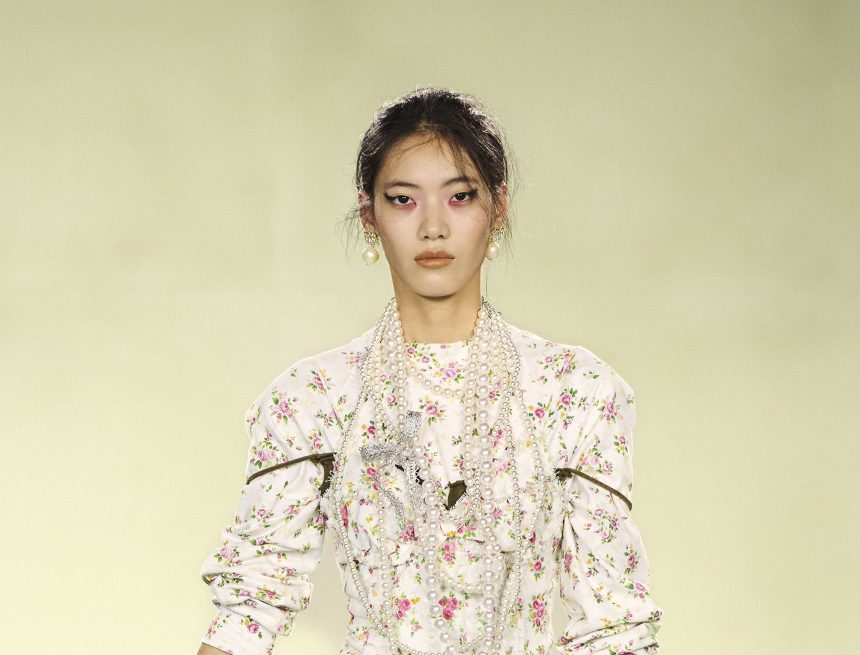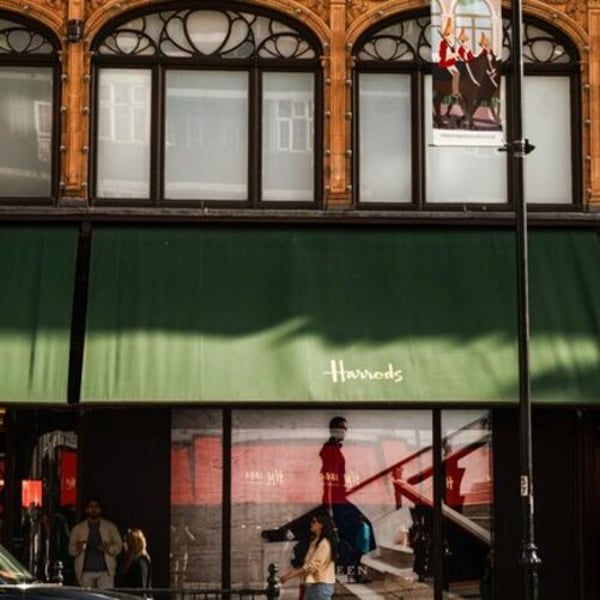Subscribe to The Frayed Edge by Sarah Kent, a weekly newsletter on how to build a cleaner, fairer fashion system.
Welcome to the hard launch of The Frayed Edge, our new-look expert briefing focused on the good, the bad and the greenwashy when it comes to efforts to build a cleaner, fairer fashion system.
Regular readers will already have a taste of the new format, and I hope you’re all enjoying reading it as much as I am writing it. Going forward, this newsletter will only be available to BoF Professional Members as part of our Expert Perspectives series. I promise you it’s worth it — on top of my musings, you’ll get to peek inside the prodigious brains of my fabulous colleagues Mike Sykes, Priya Rao and Marc Bain, who have you covered for everything you need to know on sports, beauty and tech. And there’s still more to come. If you want in, subscribe here.
Anyway, enough housekeeping. This week we’re taking a look at what Ralph Lauren’s retreat from long-term climate targets says about the state of the industry’s sustainability commitments, unpacking Brunello Cucinelli’s Russia problems and exploring why Vestiaire Collective is dabbling in one of the world’s most complex and controversial markets: carbon credits.
As always, send me thoughts, feedback, tips and questions.
Is Fashion Quiet Quitting on Climate?
Once upon a time, not so very long ago, it was considered de rigeur for any serious sustainability minded fashion brand to set a long-term goal to hit net-zero emissions.
But this week, Ralph Lauren ditched its goal to do just that.
The high-level 2040 target didn’t drive at the kind of concrete impact the company is aiming for and so it plans to focus instead on rolling five-year emissions-reduction milestones, it said.
The message: this is not a retreat, but a retrenchment intended to drive more meaningful action.
Sounds like there’s a but…
Ralph Lauren has already exceeded its current target to cut greenhouse-gas emissions 30 percent by 2030, compared to a 2020 baseline.
That’s real progress, which the company largely attributes to an elevation strategy that allowed it to earn more while making less, as well as efforts to help suppliers reduce their carbon footprint. But it’s not setting a more ambitious goal to see it through the next five years, giving it more wiggle room to hit ambitious growth targets without blowing up its climate credibility.
(Ralph Lauren’s global chief impact and communications officer, Katie Ioanilli, said the company is committed to sustaining its emissions reductions through 2030 and will set a new goal for 2035 in a few years).
The move is the latest in a series of subtle and not-so-subtle adjustments to big brands’ climate targets.
British e-tailer Asos and footwear brand Crocs both reset their net-zero commitments in 2023, stating respectively that their original goals were either not robust enough or unrealistic. A number of big-name brands have lost validation of their long-term climate targets by the Science Based Targets Initiative, the world’s leading arbiter of corporate climate goals. In May, sportswear giant Under Armour quietly announced it was reconsidering its emissions strategy.
And it’s not just fashion. This year, a host of banks and big oil companies have walked away from initiatives set up to create a collective push towards net zero. Meanwhile, a multitude of household names have made headlines for rolling back climate goals.
Eek, that sounds bad, right?
Well… it’s complicated. Let me explain.
When many companies first set these corporate climate goals, it was in a spirit of exuberant abandon, with little notion of how they might be achieved or any plans for real, near-term reductions. As UN secretary general António Guterres once put it, these commitments were made in a regulatory vacuum that left “loopholes wide enough to drive a diesel truck through.”
Over the last few years, standards have tightened up and companies are taking a closer look at what they can actually do and how they can ensure any commitments are really credible. No doubt, there are also tougher political and economic headwinds at play, helping to move sustainability down some executive agendas and dilute ambitions.
Still, “it’s not black and white anymore,” said Sybrig Smit, an analyst at climate policy-focused nonprofit NewClimate Institute. There is a situation “where headline pledges are watered down a little, but actually they’re more specific and it’s clearer what they mean… rather than these headline targets that are really just useful for PR.”
Despite the gloomy headlines, a growing number of companies are setting more and better climate targets, according to an annual net zero stocktake published by NewClimate Institute and partners last month.
At the same time, sometimes a watered down pledge is just a watered down pledge.
The Bottom Line: It’s a complicated moment for climate action and things are only likely to get more difficult. But when it comes to climate commitments the devil is really in the details, and most importantly on how brands actually deliver on the things they still say they’re going to do.
Cucinelli Claps Back at Shortsellers

Anyone who’s spent any time on corporate earnings calls will know they can be soul-destroyingly dull.
Not so Brunello Cucinelli’s latest market communications.
The brand reported its third quarter results on Wednesday, bringing forward its reporting date by a couple of weeks to deal with short seller claims that smashed the company’s share price.
So, not only were there some pretty juicy topics to deal with, but they were addressed with Cucinelli’s characteristic philosophising.
“If … this short selling activity had not occurred, it would have been preferable and less demanding for me, the two CEOs and for [investor relations], but it’s part of being listed on a stock exchange,” Cucinelli told analysts, speaking through a translator. “On this matter, I received countless messages of appreciation. For the rest, everything remained particularly special at the company.”
Wait, what’s this about?
Last Thursday, London-based short seller Morpheus Research dropped an over-80-page report claiming Brunello Cucinelli was misleading investors about its Russian business and discounting practices.
The allegations sent the company’s share price plummeting 17 percent in a single day, its steepest decline since going public in 2012.
For its part, Brunello Cucinelli used Wednesday’s earnings call to methodically reject Morpheus Research’s claims and reiterate its expectations of out-of-market strong performance.
So who said what?
Let me break it down:
The Russia Problem:
According to Morpheus Research, “Cucinelli appears to have blatantly disregarded European law by continuing to sell ultra high-value luxury goods in Russia.” (EU sanctions have banned exports of luxury goods worth more than €300 ($351) to the country since 2022).
The brand rejected the allegations. It said it has undergone over 100 customs checks since 2022, none of which raised any issues. Still, it’s hired a law firm to help review its internal controls. Retail revenue from Russia accounted for just 1.4 percent of sales at the end of the third quarter, the result of one-to-one client dealings and based on inventory already in the country, the company added.
“Our Russian business is like a candle that is melting hand in hand with the use of the inventory we had in Russia and the reduction in the number of employees,” co-CEO Luca Lisandroni told analysts.
The Discounting Dilemma
“Cucinelli has resorted to aggressive discounting to manage bloated inventory that dwarfs direct peers,” Morpheus Research wrote in its report. The brand’s products are even turning up (horror of horrors) in discount chain TJ Maxx, it said.
“We confirm the presence of a just and balanced inventory. This is the way we defined it, just and balanced for our company identity, perfectly consistent with the fundamentals of our collection offering and aligned with historical data of our ready-to-wear fashion house since its listing in 2012,” Cucinelli responded.
In other words, inventory levels aren’t an issue, according to the brand.
The Investment Case
Morpheus Research said its findings cast doubt on the company’s investment case, pitching its allegations of ongoing business dealings in Russia as a possible “attempt to compensate for more fundamental problems within the company.”
The brand said its sales grew more than 12 percent in the third quarter. Despite a broader luxury downturn, it’s targeting a 10 percent revenue increase this year and next, putting it on track to comfortably outperform most of its peers.
“We have the feeling it is going very well both in terms of numbers and product image,” said Cucinelli. “We have had the most beautiful fashion week in our history.”
Now what?
Many analysts have already shrugged off the points raised by Morpheus Research to focus instead on the brand’s positive growth story. Earlier this week, Bernstein upgraded the label to outperform. The brand’s share price has rebounded from lows hit last week, but it’s still down more than 10 percent since before the short seller report came out.
Cucinelli’s parting message to analysts this week was a story that doubled as a “that’s life” metaphor for his recent experience operating as a public company.
“We were sitting at a bar once and a foreigner turned up and he was great at playing cards and he sat at our café for four days and he won every hand,” Cucinelli said. “He counted and deceived everybody. Not me because I refused to play with him. But these are the rules of the game. There are ups and downs.”
Vestiaire Collective Wants to Make Carbon Credits Cool Again

Back in the before times (before the pandemic, before sustainability fell down executive agendas, before the leader of the free world called climate change a “con job”), there was a time when fashion was kind of into carbon credits.
These wonky financial tools allow projects or businesses that can show their operations avoid or remove planet-warming emissions to sell on these environmental benefits. Each credit represents a tonne of carbon, which big polluters like fashion brands can use to offset their own environmental footprint.
The theory is neat: climate-friendly projects are generally underfunded and carbon credits provide a way to put a market value on the environmental benefits they bring. But the whole thing is pretty controversial.
Critics have likened the market to the sale of indulgences by the Catholic church, a practice deemed so corrupt that it helped spark the Reformation. In climate terms, what this means is that companies can essentially pay to keep polluting. Worse, many high-profile schemes have come under fire for double counting or failing to deliver any real carbon benefits at all (for a wild read on how one of the world’s largest cash-for-carbon projects unravelled, check out this New Yorker piece).
Believers in the potential for carbon markets to drive real positive impact — of which there are still many — have been working hard to restore trust and credibility to the sector. The market is undergoing an overhaul as standards are tightened and guidelines for use are clarified.
And while many fashion companies have quietly stopped talking about carbon credits, resale platform Vestiaire Collective wants to bring them back.
What’s Vestiaire Doing?
On Thursday, the French luxury re-commerce business announced it was launching its own line of carbon credits — a first-of-its-kind initiative for fashion, according to Vestiaire.
The company says it can do this because its sale of secondhand clothing avoids lots of the planet-warming emissions associated with making new products. It spent four years building out the data and methodology to help back this up, and worked with French decarbonisation agency Inuk to verify its workings.
This year, Vestiaire is putting 55,000 credits on the market at €34 ($40) a piece. Each one represents a tonne of carbon the company estimates was avoided as a result of its pre-loved clothing sales in 2023 and 2024.
If they all sell, the company stands to make nearly €1.9 million off its climate claims.
(If you want more details check out Shayeza Walid’s story from earlier this week).
So What?
Vestiaire has proved adept at making wonky sustainability topics into marketable moments. A few years ago, the company launched a fast-fashion ban, making a conversational virtue of doubling down on the higher-value sales that drive its business.
The idea with the carbon credits is to make a bigger point, said chief impact officer Dounia Wone. Across industries, circular business models like resale are struggling to compete in a market where low-cost convenience is king, regulatory support is lagging and intense political and economic volatility is sapping appetite for investment in business model innovation. But if less polluting companies could earn money from their environmental efforts, that could change the game, Wone argues.
“Look at the size of the circular market… how much are we going to win until we have a true financial incentive?” she said. “We need to refocus on business.”
Still, the project is very much an experiment. And one in an extremely tough market at that.
A key question is whether potential buyers find the brand’s methodology credible. Avoided emissions can be hard to back up and studies on resale’s environmental benefits often differ. Vestiaire’s partner, Inuk, is in the process of gaining accreditation from ICROA, a well-established nonprofit that approves carbon crediting programmes. But the organisation emphasises that it doesn’t certify such schemes’ underlying methodologies.
Meanwhile, even though tightening standards over the last few years should pave the way to restore trust in voluntary carbon markets, they’ve also emphasised that companies should focus first on cutting their own emissions before turning to credits.
“The challenge with the carbon market at the moment is that it has a supply and demand problem,” said Lindsey Hibberd, the associate director for climate finance at decarbonisation consultancy Carbon Trust.
The Bottom Line: Corporate climate action is in its “show me the money era” and this is an interesting play, but driving more than conversation may prove tough.
What makes people choose second-hand before sustainability, is affordability. Even though in the world of Shein and Temu we might never be on the same ground, we will maybe convince more people that it works to choose second-hand over first-hand.
— Vestiaire Collective chief impact officer, Dounia Wone
WHAT ELSE YOU NEED TO KNOW THIS WEEK:
- Shein Mon Dieu: The ultra-fast-fashion brand is facing a backlash in France, where it is planning to open its first permanent physical stores. A petition to ban the brand has gained 270,000 signatures, while Galeries Lafayette has objected to plans that would see Shein open in stores that bear its name. [The Business of Fashion]
- Trade Gloom: Trump’s tariffs, the expiration of a key US-Africa trade deal and a variety of other cuts are sending disastrous shockwaves through apparel-making communities around the world. [Foreign Policy, Sourcing Journal]
- Fake Out: A US federal judge ordered the owners of a Georgia shopping centre to pay Louis Vuitton $584 million in damages, one of the largest-ever penalties tied to the sale of counterfeit goods. [The Business of Fashion]
- Hair Scare: Following a flurry of headlines alleging that synthetic hair extensions contain harmful chemicals, British company Ruka is launching a lab-made option using a complex formulation process, which it says is a safer alternative. [The Business of Fashion]
- It’s All About Them Bots: Coordinated bot networks powered by AI tools are becoming a growing problem for consumer brands, amplifying online outrage over issues like the rollback of diversity, equity and inclusion targets. [The Wall Street Journal]


